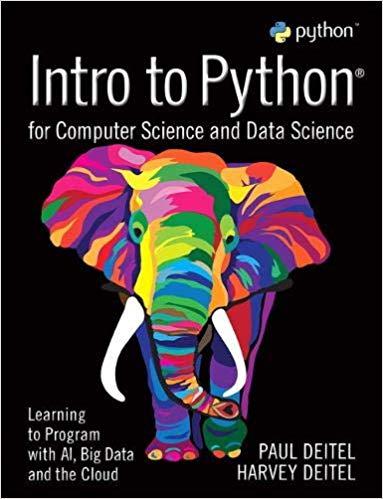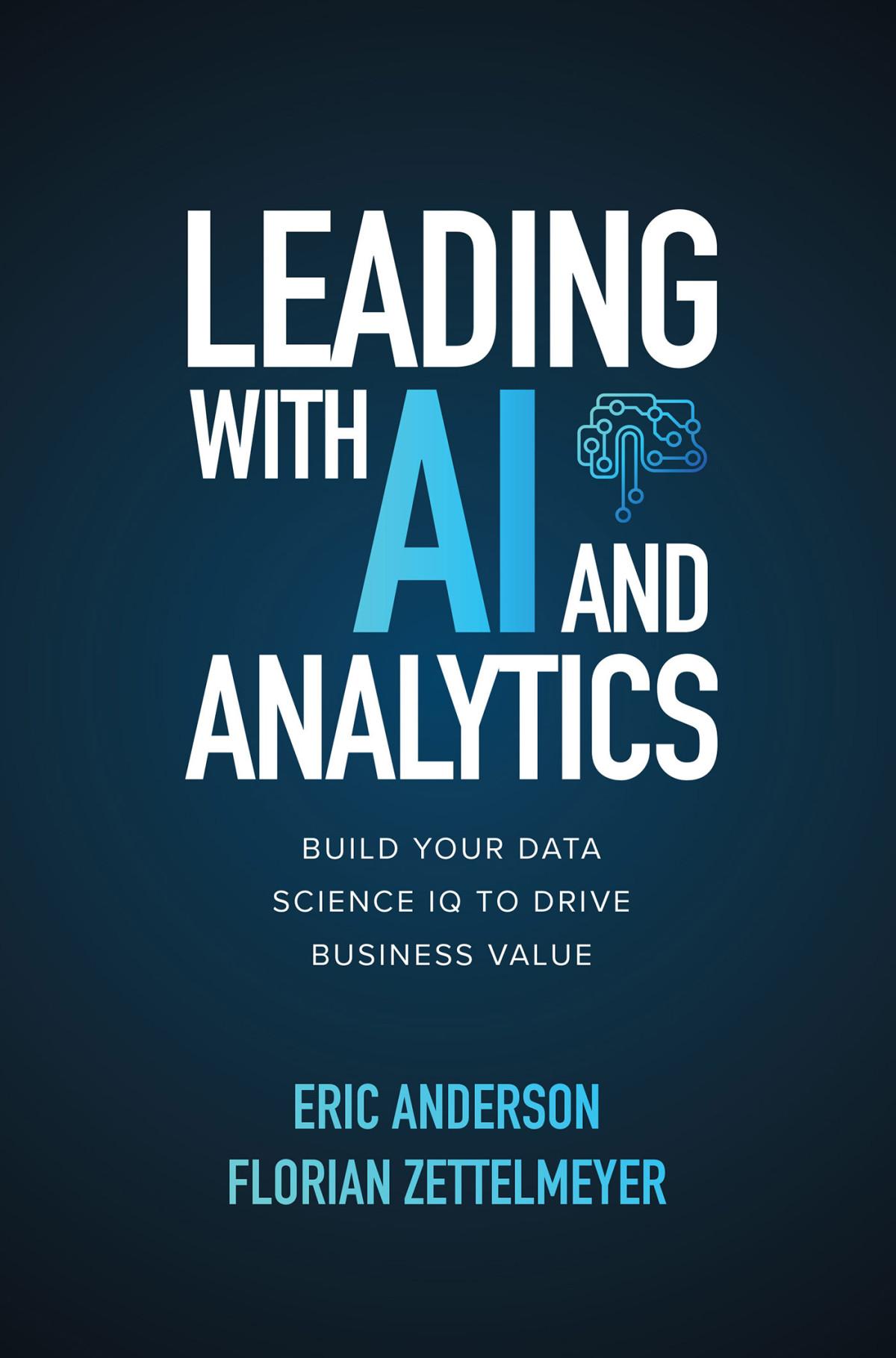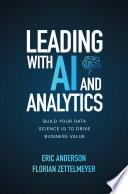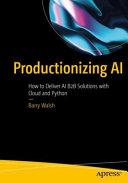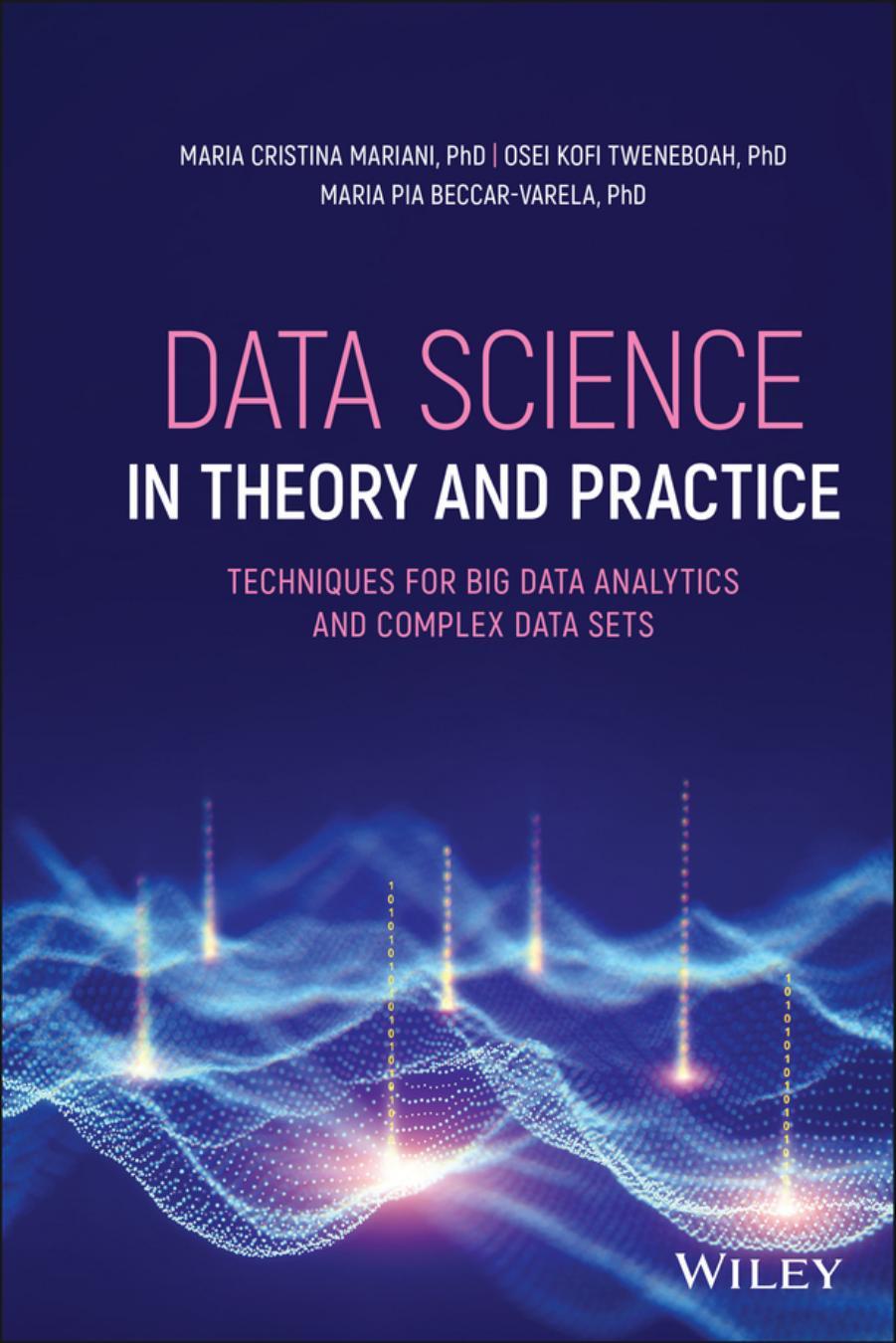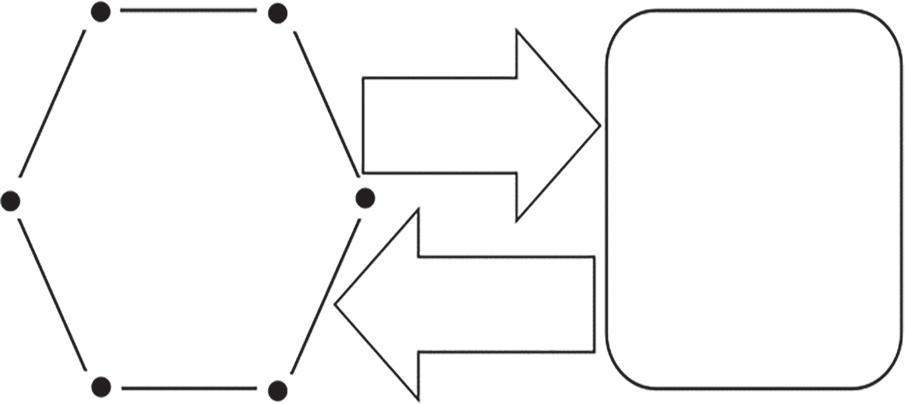Convergence of Cloud with AI for Big Data Analytics
Foundations and Innovation
Edited by Danda B. Rawat
Lalit K Awasthi
Valentina Emilia Balas
Mohit Kumar and
Jitendra Kumar Samriya
This edition first published 2023 by John Wiley & Sons, Inc., 111 River Street, Hoboken, NJ 07030, USA and Scrivener Publishing LLC, 100 Cummings Center, Suite 541J, Beverly, MA 01915, USA © 2023 Scrivener Publishing LLC
For more information about Scrivener publications please visit www.scrivenerpublishing.com.
All rights reserved. No part of this publication may be reproduced, stored in a retrieval system, or transmitted, in any form or by any means, electronic, mechanical, photocopying, recording, or otherwise, except as permitted by law. Advice on how to obtain permission to reuse material from this title is available at http://www.wiley.com/go/permissions.
Wiley Global Headquarters
111 River Street, Hoboken, NJ 07030, USA
For details of our global editorial offices, customer services, and more information about Wiley products visit us at www.wiley.com.
Limit of Liability/Disclaimer of Warranty
While the publisher and authors have used their best efforts in preparing this work, they make no representations or warranties with respect to the accuracy or completeness of the contents of this work and specifically disclaim all warranties, including without limitation any implied warranties of merchantability or fitness for a particular purpose. No warranty may be created or extended by sales representatives, written sales materials, or promotional statements for this work. The fact that an organization, website, or product is referred to in this work as a citation and/or potential source of further information does not mean that the publisher and authors endorse the information or services the organization, website, or product may provide or recommendations it may make. This work is sold with the understanding that the publisher is not engaged in rendering professional services. The advice and strategies contained herein may not be suitable for your situation. You should consult with a specialist where appropriate. Neither the publisher nor authors shall be liable for any loss of profit or any other commercial damages, including but not limited to special, incidental, consequential, or other damages. Further, readers should be aware that websites listed in this work may have changed or disappeared between when this work was written and when it is read.
Library of Congress Cataloging-in-Publication Data
ISBN 978-1-119-90488-5
Cover image: Pixabay.Com
Cover design by Russell Richardson
Set in size of 11pt and Minion Pro by Manila Typesetting Company, Makati, Philippines
2.2.8
5.4
6.1.2
6.1.2.1
6.1.3
6.1.5
6.1.5.1
7.2.3
7.2.4
7.1.3.1
7.1.3.3
8.1.2
8.1.3
8.1.4
9
Shalini Sharma Goel, Anubhav Goel, Mohit Kumar and Sachin Sharma
9.3
9.3.1
9.3.2
11 Axiomatic Analysis of Pre-Processing Methodologies Using
Tajinder Singh, Madhu Kumari, Daya Sagar Gupta and Nikolai Siniak
11.1
11.4
11.5
11.7
12
Kamalpreet Kaur, Renu Dhir and Mariya Ouaissa
Jitendra K. Srivastava, Deepak Kumar Verma, Bholey Nath
and Chayan Kumar
15
Dilip Kumar Choubey, Chandan Kumar Jha, Niraj Kumar, Neha Kumari and Vaibhav Soni
Amar Shukla, Rajeev Tiwari, Saurav Raghuvanshi, Shivam Sharma and Shridhar Avinash
Preface
This book was written to discuss the milestones in the development of three recent domains in computer science engineering—Cloud Computing, Artificial Intelligence and Big Data Analytics—and to analyse the convergence of cloud computing with artificial intelligence for big data analytics. Despite the fact that all three domains work separately, they can be linked in interesting ways. However, even though AI and big data can be easily linked, because AI needs a huge amount of data to train the model, they still suffer from a data storage issue. This drawback can be addressed with the help of cloud computing, which makes it possible to provide ondemand services to the client in terms of computer resources, such as storage and computing power, without the need for user management. This book aims to provide the scope of research on the discussed technologies.
Structure of the Book
The 17 chapters of the book cover the intertwining concepts of three key levels that are of interest to the scientific community:
1. Artificial Intelligence
2. Big Data
3. Cloud Computing
A chapter-wise breakdown of the contents of the book follows:
• Chapter 1 discusses the integration of artificial intelligence, big data and cloud computing with the internet of things (IoT).
• Chapter 2 discusses cloud computing and virtualization.
• Chapter 3 presents a time and cost-effective multi-objective scheduling technique for cloud computing environment.
Preface
• Chapter 4 discusses cloud-based architecture for effective surveillance and diagnosis of COVID-19.
• Chapter 5 presents smart agriculture applications using cloud and the IoT.
• Chapter 6 presents applications of federated learning in computing technologies.
• Chapter 7 analyzes the application of edge computing in smart healthcare.
• Chapter 8 discusses a smart agriculture application using Fog-IoT.
• Chapter 9 presents a systematic study of the global impact of COVID-19 on the IoT.
• Chapter 10 discusses efficient solar energy management using IoT-enabled Arduino-based MPPT techniques.
• Chapter 11 presents an axiomatic analysis of pre-processing methodologies using machine learning in text mining from the perspective of social media in the IoT.
• Chapter 12 presents an app-based agriculture information system for rural farmers in India.
• Chapter 13 provides a systematic survey on AI-enabled cyber-physical systems in healthcare.
• Chapter 14 discusses an artificial neural network (ANN) aware methanol detection approach with CuO-doped SnO2 in gas sensor.
• Chapter 15 describes how to detect heart arrhythmias using deep learning algorithms.
• Chapter 16 presents an artificial intelligence approach for signature detection.
• Chapter 17 compares various classification models using machine learning to predict the price range of mobile phones.
Acknowledgment
Writing this book has been a rewarding experience, which was enhanced by the tremendous effort of a team of very dedicated contributors. We would like to thank the authors for their respective chapters and also express our thanks to the list of editors who provided suggestions to improve content delivery. All feedback was considered, and there is no doubt that some of the content was influenced by their suggestions. We especially would like
Preface xvii
to thank the publisher, who believed in the content and provided a platform to reach the intended audience. Finally, we are thankful to our families for their continued support. Without them, the book would not have been possible.
The Editors October 2022
1 Integration of Artificial Intelligence, Big Data, and Cloud Computing with Internet of Things
Jaydip Kumar
Department of Computer Science, Babasaheb Bhimrao Ambedkar University, Lucknow (UP), India
Abstract
The Internet of Things (IoT) provides to the client an effective technique for communicating with the Web world through ubiquitary object enabled networks. The rapid progress in IoT connected devices creates a huge amount of data in a second from personal and industrial devices. This information should be utilized to help business and functional objectives. Thus, there is an urgent requirement for adopting cloud computing, big data, and artificial intelligence techniques to enable storage, analytics, and decision making. In this article, we focused our consideration to integrate Cloud Computing, Big data and Artificial Intelligence technique with the Internet of Things devices. Cloud computing, Big Data, Artificial Intelligence, and IoT are different techniques that are already part of our life. Their adoption and uses are expected to make them more comprehensive and make them essential components of the future Internet. The Internet of Things (IoT) is a system of interconnected gadgets, digital or mechanical machines that are given exceptional identifiers and the capacity to move information over an organization without expecting human-to-human or human-to-pc collaboration.
Keywords: Artificial intelligence, big data, cloud computing, Internet of Things
Email: jaydipkumar2001@gmail.com
Danda B. Rawat, Lalit K Awasthi, Valentina Emilia Balas, Mohit Kumar and Jitendra Kumar Samriya (eds.) Convergence of Cloud with AI for Big Data Analytics: Foundations and Innovation, (1–12) © 2023 Scrivener Publishing LLC
1.1 Introduction
With the wide-spread discovery of techniques in the current digital era, increasing physical entities are interconnected to the Internet of Things (IoT) devices. In recent years IoT technologies are applied with different techniques such as Artificial Intelligence, Big Data, and Cloud Computing. Artificial Intelligence (AI) is a technique which has the ability to compute a huge amount of task that is usually done by a human. Artificial Intelligence uses different learning techniques to facilitate automatic rules and regulations for decision making. Artificial intelligence is divided into two different modules such as learning module and predicate module [1]. The learning module is used for effective data collection, training, and data modeling. And the predicate module is used to take action on the current situation. The flow and storage of exponentially increasing data are easily managed by Artificial Intelligence (AI). The integration of cloud computing and IoT are also two different technologies that assume a vital part in our daily life. Cloud computing and the Internet of Things are merged together is expected to break both current and future internet which we called as new paradigm CloudIoT [2]. In the era of the internet which plays a fundamental role in cloud computing, it seems to be represented as a medium or the platform through which many different cloud computing services are accessible or delivered its services. If you are thinking that the internet as a virtual “space” for connecting users from over the globe, it is like a cloud, sharing information by using the internet. Cloud computing is the trending technology in the daily life of everyone which provides on-demand web services such as networking devices, data storage, servers, and applications. It provides higher flexibility and cost efficiency while users try to use cloud computing resources and applications. The different number of connected devices has already exceeded the number of users on the earth. This is due to exponential increase of connected devices rapidly increasing huge amount of data as well. The storage of data locally and temporarily will not be possible to access different devices which are connected to each other. There is a need to be centrally storage space which is provided by cloud storage [3]. And the intense invention in the Internet of Things (IoT) technologies, the Big Data technique has critical data analytics tools which bring the knowledge within the IoT devices to make the better purpose of IoT systems and support critical decision making. Big Data has been divided into five fundamental bases such as volume, variety, velocity, veracity, and value. The volume indicates the size of the data. And the different types of data from different sources are known as variety. The real-time data collection is known as velocity, and veracity is the uncertainty of data and the value which shows the benefits

of different industrial and academic fields [4]. The combination of IoT and Big Data has created opportunities to develop complex systems for different industries such as healthcare, smart city, military and agriculture, education, etc. The flow diagram of AI, Big data, and cloud computing integrated with the Internet of Things is given below in Figure 1.1.
1.2 Roll of Artificial Intelligence, Big Data and Cloud Computing in IoT
Internet of Things (IoT) is an interconnection of various devices which are connected to each other through the internet and exchange information. These IoT devices generate a huge amount of information [5]. Artificial Intelligence (AI) uses the decision-making support system to provide data flow and storage in IoT networks. The integration of artificial intelligence (AI) with the Internet of Things (IoT) techniques will generate extraordinary value-creation opportunities. The IoT devices with AI enabled the rise of a “factory of the future” [6]. This increases the efficiency, turnaround, and waiting time and reduces the cost. The IoT with AI is used in different fields such as 3D printing, Robotics, the food industry, manufacturing, logistics, and supply chain management. These fields create lots of information in a regular mode which is centrally stored in cloud computing.
Figure 1.1 Flow diagram of AI, big data, and cloud computing integrated with Internet of Things.
It can be said that the cloud with IoT will be the future of the next generation of the internet. However, the cloud computing services are fully dependent on cloud service providers but IoT technologies are based on diversity [7]. Cloud computing reduces the cost of the use of applications and their services for users. It also simplifies the flow of Internet of Things data capturing and processing and also provides fast and cheapest cost integration, installation, and deployment. And without Big Data analytic applications, the huge amount of data generated by the IoT devices creates an overhead for any business. Due to this any organization must know how to handle this massive amount of data that is collected by the IoT devices. Fetching accurate data is not a problem for any organization; the challenge is to get the necessary skills in the analytical analysis field to deal with big data [8].
1.3 Integration of Artificial Intelligence with the Internet of Things Devices
For addressing any problem AI needs to two-step process which is shown in Figure 1.2. A set of AI models has been created in the first stage. The models are created by the machine learning algorithm with a set of training data. These trained data are processed by the natural language documents or by the encoding of human expertise [14]. The models are invented in different categories like neural networks, decision trees, and inference rules. The models use the inferences from the Internet of Things sensor’s input data and guide the operations of the system [9, 18]. There are lots of work have been completed with the integration of Artificial intelligence and Internet of Things. We have mainly surveyed previous works on the personal and industrial applications such as attendance monitoring system, human activity and presence in hospitality, agricultural applications, hospital, human stress monitoring [15, 21]. The short review of IoT applications domains are given below Table 1.1 and the difference between the AI and IoT are given below in Table 1.2.

Figure 1.2 Integration architecture of AI in IoT.
AI, Big Data, and Cloud Computing with IoT 5
Table 1.1 Recent Artificial Intelligence based Internet of Things applications.
Problem Techniques
Wearable devices
Human attendance system
Data
Decision tree, logistic regression Health data
Random forest, decision tree etc. Images
Smart meter operationBayesian network, naïve Bayes, decision tree, random forest Meter reading data
Parking space detection
Human stress detection
Clustering algorithms Camera data
SVM, logistic regressionPulse waveform
Table 1.2 Table of differences between the internet of things and artificial intelligence.
Based onInternet of things
Connection type A set of interconnecting devices over the network
Capability Capabilities of the devices are known prior
InteractionInteraction of human between the devices is needed
Future scope Interaction of human between the devices is needed
Instruction need Instruction needed to IoT devices
DependencyIoT devices cannot work without artificial intelligence
ApplicationsSmart home, smart city, medical, water monitoring etc.
Artificial intelligence
Interconnection and machine independent is not needed
The capabilities never be predicted of machine
Interaction of human between the devices is not needed
Machine can learn and start reacting more than human
Machines can learn from experiences
Artificial intelligence is not dependent on IoT devices
Fraud prevention, voice assistant, personalized shopping, AI-powered assistants etc.
1.4 Integration of Big Data with the Internet of Things
The generations of the huge amount of data are collected from the Internet of Things devices and its sensors leads to an exponential incremental in data. This data needs to manage, processed, and analyzed by the organization [10] which is shown in Figure 1.3. IoT technology is a major source of Big Data which motivates the organization to deploy Big Data technology and its applications to acquire the needs of IoT technologies. The collected data from the IoT devices is managed, processed, and analyzed by the big data. Big Data provides a framework for data transmission and processing which support IoT data and virtualization. The provided data become deep and more complicated to be stored and analyzed by conventional technology. So the broad consensus is that the big data and Internet of Things techniques are highly interconnected [11]. The architecture of Big Data integrated with the Internet of Things is given below in Figure 1.3 and the comparative study of big data applications is given below [17] in Table 1.3.
1.5 Integration of Cloud Computing with the Internet of Things
The combination of cloud computing and IoT are efficient for every business or user. This enhanced the efficiency of every task and reduced the setup cost for applications, servers, storage spaces, etc. The different cloud provider provides cloud services pay as requirements model, where cloud
Focus: industrial devices, communication
data acquisition data storage, data analystics, data visualization
Focus: distributed data, parallel processing
1.3 Integration architecture of big data with internet of things devices.
IIoT
Big Data
Figure
Table 1.3 Comparisons of big data applications.
Applications
Sources
Healthcare Patient and laboratory data, gene expression data, risks and emotions of user’s data.
Government Sectors
Retails and customer products
Agriculture
Governmental defense data, scientific and technological data, education data, treasury, power and energy records, employment records.
Sales and purchasing records, marketing, accounting, inventory and feedback data.
Weather information, agricultural drones and videos and images, soil’s map and fertilities data, global positioning system (GPS) records.
Characteristics
Text, structured, images, videos, hypertext
Text, images, videos, audios
Text, audio, videos, hyperlinks, emotional symbols
Text, number, images videos
Banking sectors
Transportation
Transactional information, customer’s information, policies, loans, accounts, financial information.
Transport information, tracking devices information, GPS information, accidental information, vehicles and products information.
Text, numbers, images
Text, numbers, images, videos, hyperlinks, audios
user can pay for the particular services used [22]. When an organization needs to collect a huge amount of data from the IoT device sensors, each sensor needs a large amount of computation power and storage space. This problem is solved by the combination of Cloud computing and Internet of Things techniques, in which the IoT sensors uses the cloud resources and store the collected information in a centralized manner [12]. The architecture of cloud computing with the Internet of Things is given below in Figure 1.4. Cloud computing and the Internet of Things contain different characteristics which are compulsory for each other which is shown in Table 1.4. Due to these characteristics, the integration of Cloud computing and IoT gives an excellent solution to real-world problems [13].
Figure 1.4 Architecture of cloud computing with internet of things.
Table 1.4 Characteristics of the internet of things and cloud computing.
Cloud computing Internet of thingsCharacteristics
Give procedure to manageProducer Big Data
Provide virtually unlimited Limited Storage
Provide virtually unlimited Limited Computational services
Centralized servicesWidespread Displacement
Comprehensive Limited Reachability
Mode of service providingPoint of convergence Internet role
The integration of Cloud computing and Internet of Things can be divides in three categories such as cloud platform, infrastructure and IoT middleware. Cloud computing removes the IoT limitations and provided opportunities for the business and it is managed by the cloud infrastructure. The IoT provides interconnection between the IoT devices and Cloud platform for data exchange.
1.6 Security of Internet of Things
The security challenges of IoT technologies are directly related to their applications. The aim of the IoT technique is to provide the combination
Computing
Network Network
of both physical and digital world in a single ecosystem which created the new intelligent era of web world [16, 23]. IoT provides huge business and opportunities for organizations such as energy, healthcare, government and other sectors. Due to this enhancement of IoT techniques, it suffers from different security issues which are more challenging to secure its data and applications [19]. The IoT devices faced different security issues such as privacy of data, authorization, verification, access control, data storage management, etc. The few security challenges are given below in Table 1.5. In IoT, the wireless communication channel involves radio communications,
Table 1.5 Internet of Things security requirements.
Security requirementsDescription IoT security properties
Availability The resources of the IoT devices are readily available.
Integrity It is accuracy, consistency of data and its services, trustworthiness of IoT life cycle.
IoT resources must be attack free from the denial of service (DoS) attacks.
The security algorithms must be capable of detecting modification and manipulation of data breaches on IoT devices.
ConfidentiallyThe protection from the unauthorized users and access.
AuthenticationIt authenticate that the user is genuine user.
Authorization Prevented the illegal uses of IoT devices or resources.
Access ControlProvided management and prevent unauthorized user and access to IoT resources and data.
The security technique must be capable of verification and authentication of user.
Only authorized or legal user can access the network
Ensured that the IoT devices are verified and authorized to access the IoT data.
transmitters, and receivers for the information exchange between two IoT devices. So this communication channel suffers from different security threats and attacks such as man-in-middle attacks, communication signal loss, hacking of data, Denial of service attacks, protocol tunneling [20].
1.7 Conclusion
The Internet of Things is a wide field and contains incredible and different variety of applications. The main aim of IoT is to provide a facility of exchange information and synergic performance between devices and peoples via global machine-to-machine (M2M) networks. Due to M2M network, exchange of information between the devices creates an exponential amount of data. It is impossible to manage or keep secure these generated personal or organizational data in local devices. The IoT techniques need centrally storage space for personal or industrial data. To avoid these problems, in this paper we have introduced the integration of Cloud Computing, Big Data and Artificial Intelligence techniques with the Internet of Things devices. The integration of cloud computing with IoT techniques stores the information centrally generated by the IoT devices. And the collected data which is centrally stored in cloud computing is managed, processed, and analyzed by the Big Data Techniques. To extract the high volume of IoT data in real-time, processing needs machine learning and AI algorithms.
References
1. Guo, K., Lu, Y., Gao, H., Cao, R., Artificial intelligence-based semantic internet of things in a user-centric smart city. Sensors, 18, 5, 1341, 2018.
2. Botta, A., De Donato, W., Persico, V., Pescapé, A., Integration of cloud computing and Internet of Things: A survey. Future Gener. Comput. Syst., 56, 684–700, 2016.
3. Aazam, M., Khan, I., Alsaffar, A.A., Huh, E.N., Cloud of things: Integrating internet of things and cloud computing and the issues involved, in: Proceedings of 2014 11th International Bhurban Conference on Applied Sciences & Technology (IBCAST), Islamabad, Pakistan, 14th-18th January, 2014, IEEE, pp. 414–419, 2014.
4. Ge, M., Bangui, H., Buhnova, B., Big data for internet of things: A survey. Future Gener. Comput. Syst., 87, 601–614, 2018.
AI, Big Data, and Cloud Computing with IoT 11
5. Mohamed, E., The relation of artificial intelligence with internet of things: A survey. J. Cybersecur. Inf. Manage., 1, 1, 30–24, 2020.
6. Ramadoss, T.S., Alam, H., Seeram, R., Artificial intelligence and Internet of Things enabled circular economy. Int. J. Eng. Sci., 7, 9, 55–63, 2018.
7. Atlam, H.F., Alenezi, A. et al., Integration of cloud computing with internet of things: Challenges and open issues, in: 2017 IEEE International Conference on Internet of Things (iThings) and IEEE Green Computing and Communications (GreenCom) and IEEE Cyber, Physical and Social Computing (CPSCom) and IEEE Smart Data (SmartData), IEEE, pp. 670–675, 2017.
8. Alansari, Z., Anuar, N.B. et al., Challenges of internet of things and big data integration, in: International Conference for Emerging Technologies in Computing, Springer, Cham, pp. 47–55, 2018.
9. Calo, S.B., Touna, M. et al., Edge computing architecture for applying AI to IoT, in: 2017 IEEE International Conference on Big Data (Big Data), IEEE, pp. 3012–3016, 2017.
10. Nasrulla, K. and Anitha K., Perception of relationship between Big Data and Internet of Things, International Journal of Advanced Research in Computer and Communication Engineering, 4, 12, 264–267, DOI 10.17148/ IJARCCE.2015.41261.
11. Al-Gumaei, K., Schuba, K., Friesen, A. et al., A survey of internet of things and big data integrated solutions for industries 4.0, in: 2018 IEEE 23rd International Conference on Emerging Technologies and Factory Automation (ETFA), vol. 1, IEEE, pp. 1417–1424, 2018.
12. Kaur, C., The cloud computing and Internet of Things (IoT). Int. J. Sci. Res. Sci., Eng. Technol., 7, 1, 19–22, 2020.
13. Malik, A. and Om, H., Cloud computing and internet of things integration: Architecture, applications, issues, and challenges, in: Sustainable Cloud and Energy Services, pp. 1–24, Springer, Cham, 2018.
14. Sepasgozar, S., Karimi, R. et al., A systematic content review of artificial intelligence and the internet of things applications in smart home. Appl. Sci., 10, 9, 3074, 2020.
15. Yashodha, G., Rani, P.P. et al., Role of artificial intelligence in the Internet of Things–A review, in: IOP Conference Series: Materials Science and Engineering, vol. 1055, No. 1, IOP Publishing, p. 012090, 2021.
16. Abiodun, O.I., Abiodun, E.O. et al., A review on the security of the internet of things: Challenges and solutions. Wireless Pers. Commun., 119, 3, 2603–2637, 2021.
17. Bendre, M.R. and Thool, V.R., Analytics, challenges and applications in big data environment: A survey. J. Manage. Anal., 3, 3, 206–239, 2016.
18. Tien, J.M., Internet of things, real-time decision making, and artificial intelligence. Ann. Data Sci., 4, 2, 149–178, 2017.
19. Kouicem, D.E., Bouabdallah, A., Lakhlef, H., Internet of things security: A top-down survey. Comput. Networks, 141, 199–221, 2018.
20. Alaba, F.A., Othman, M. et al., Internet of things security: A survey. J. Netw. Comput. Appl., 88, 10–28, 2017.
21. Cui, L., Yang, S., Chen, F. et al., A survey on application of machine learning for Internet of Things. Int. J. Mach. Learn. Cybern., 9, 8, 1399–1417, 2018.
22. Kumar, J., Cloud computing security issues and its challenges: A comprehensive research. Int. J. Recent Technol. Eng, 8, 1, 10–14, 2019.
23. Kumar, J. and Saxena, V., Asymmetric encryption scheme to protect cloud data using paillier-cryptosystem. Int. J. Appl. Evol. Comput. (IJAEC), 12, 2, 50–58, 2021.


